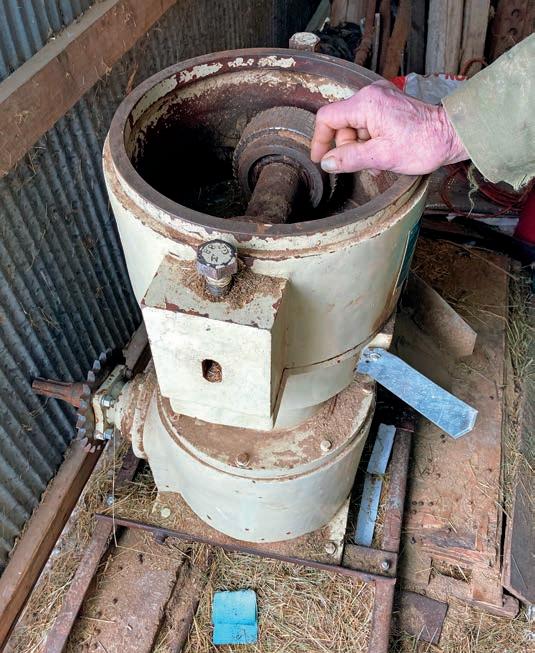
7 minute read
Rabbit producer holds on to niche market
Perry Cuperus holds a New Zealand white rabbit in his barn Jan. 20 near Sebeka, Minnesota. Michael Johnson / Agweek
By Michael Johnson | Agweek
SEBEKA, Minn — Perry Cuperus learned as a pre-teen growing up in Michigan that you just don’t pull rabbits out of a hat.
While on some ‘hare’ raising tours in Vietnam, Afghanistan and Bosnia, and numerous far flung journeys as a Seabee, rabbit raising was always the hobby he kept coming back to. At its peak, his family had up to 1,000 rabbits.
When Cuperus returned to the states and found a home near Sebeka, Minnesota, in about 1996, he continued his pursuits in raising livestock. That included various cattle, chickens and rabbits.
Keeping up with maintenance issues for all the different animals in sub-zero Minnesota winter got to be more than Cuperus and his wife, Sue, wanted to do at their age. Their cattle grounds are now rented out to another producer, but the hobby of raising rabbits continues at the heart of the main barn at the Cuperus farm.
Their operation is not for everyone. These are snow white New Zealand rabbits. Some might consider them cute and cuddly, but ultimately — they’re raised for their meat.
“It’s a miniature hog operation,” Cuperus said, as he described his method of raising rabbits.
In an old hog barn, Perry, age 74, has retrofitted half the barn for rabbits — about 200 does and 25 bucks — and another portion of the barn is for egg laying chickens and guinea hens. A gravity fed watering system has a water line attached to every cage. Feeding is done by hand, with stops at each rabbit. Cuperus continues to work with the animals daily and tinker in his sheds with ways to develop cost saving methods. That includes making his own cages and feeders from wire and tin he picks up on the cheap at area auctions.

Perry Cuperus talks about his pellet maker on Jan 20. He gathers an assortment of grains and grass cuttings to create his rabbit feed with this machine.
Michael Johnson / Agweek
It also involves making his own feed, largely with a base of grass clippings he harvests each year from a 10-acre field. He then mixes the grass with corn, soy and wheat grains and puts the mix through a pellet making machine. It’s allowed him to cut his feed costs in half.
“If you can’t make any money that way, you ain’t gonna make any money,” Cuperus said.
Cuperus credits his time in the service and as a contractor for teaching him a great deal about how to make things work.
“When you’re doing things, you learn things,” he said. Some may wonder, why meat rabbits? There’s not a booming market for rabbits. In fact, most consumers wouldn’t even consider it. Even finding a state-inspected processor is difficult for the niche product, as many just don’t want to deal with rabbits. It can be a high cost for a small product.
But there are groups of people accustomed to eating rabbit and so, Cuperus continues to provide.
“New Zealand, that’s your Hereford of the rabbit industry, or Black Angus, ya know,” Cuperus said. He said you can feel the difference with these meat rabbits in that they have more meat on the loins than other breeds.
Dollar for dollar, Cuperus said you can’t get meat with higher protein. He said his rabbits average between 20-21% protein. Others concur.
“Rabbit meat has the highest percentage of protein per pound than chicken, veal, turkey, lamb, beef, and pork,” according to a Rutgers University study. In the study it points out that while rabbit makes up a significant portion of the diet for many consumers in other countries, U.S. consumers are standoffish. The study points out that rabbits could perhaps be an answer to world hunger. There’s a project going on in Haiti where Partners of the Americas is training farmers to raise rabbits to help the people produce quality food to combat hunger and earn money while doing it.
While commonplace 100 years ago, getting people eating rabbits today takes education, according to Cuperus. Perry and his wife Sue make trips to the local schools educating kids about raising rabbits. They bring with them the ingredients that it takes to make the pellet feed for the rabbits. They also bring along a rabbit or two to show off, which the kids enjoy. Sue even dresses up as the Easter Bunny to visit the kids at school. Talk of butchering those fuzzy bunnies, however, is a subject the couple treads lightly around.
You don’t find too many people like Cuperus, who raise meat rabbits at this level of production. In fact, he doesn’t know anyone else who does it.

Perry Cuperus thumbs through one of his rabbit raising books he has learned from over the years of producing in his rural Sebeka home.
Michael Johnson / Agweek
Perry has some ideas why. For one thing, they just aren’t a common item to find in your local grocery store, so most people have never even tried it. Even for the Cuperus couple, rabbit is not a big part of their diet, but they do make various dishes including some rabbit chili they enjoyed last week from ground rabbit meat. Some customers enjoy getting some for the barbecue grill or slow cooking the lean meat.
We can’t hop over the fact that many people just can’t imagine eating something that many people see as a pet.
“The downsides of eating rabbit meat are mostly psychological,” according to WebMD.com. People may view them as a pet, even if they never had one as a pet.
Perry says rabbit meat is not quite like chicken, but it pretty much tastes like the seasoning that you put on it.

Rabbits in a cage at the Cuperus Farm in rural Sebeka.
Michael Johnson / Agweek
Even though Perry spent many years traveling and showing these rabbits, producing them for meat has also been a part of the process. He explained why:
• They have fast weight gain. It’s typically eight to 10 weeks to reach a processing weight of 4-6 pounds.
• Rabbits don’t take up a lot of space.
• The rabbits breed easily. Their gestation is about 28-32 days and they can have up to five litters a year. As the saying goes, “they breed like rabbits.”
Cuperus isn’t set on pushing the rabbits too hard, but he recognizes that some rabbits have eight to 13 young at a time, making them very high producers.
“The more you can push in and the more you can push out, the more you can make, or the more you can give away,” he said. Similarly, when the Cuperuses have more eggs than they can sell, they donate the rest to the local food shelf.
• Rabbit meat is very high in protein (about 20.2% protein) and low in fat. “Rabbit is a lean protein, which means that it’s good for your heart and won’t contribute to high cholesterol or heart disease,” according to WebMD.com.
• Rabbit meat can be a good meal, as it has a mild flavor that can be seasoned to taste and used in many dishes, including stews and stir-fries.
Even in his 70s, with 22 grandchildren and a growing number of great grandchildren to chase after, Perry still has dreams of improving his rabbit operation. As a tinkerer, he believes there’s always room for improvement.
If you think you’re going to make it big raising rabbits, think again, Perry said. But if you want to give it a try, it’s extremely low cost to start. Perry said, with the purchase of “a buck and a couple does” and a steady supply of food and water, you are well on your way to high production.









